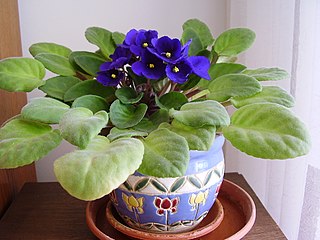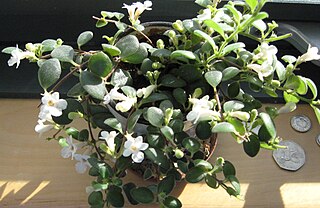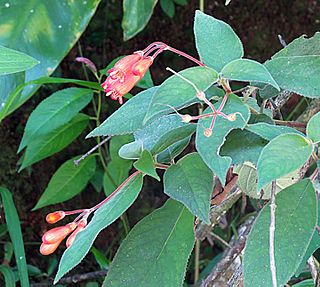
Gesneriaceae, the gesneriad family, is a family of flowering plants consisting of about 152 genera and ca. 3,540 species in the tropics and subtropics of the Old World and the New World, with a very small number extending to temperate areas. Many species have colorful and showy flowers and are cultivated as ornamental plants.

Kai Larsen was a Danish botanist.

Kohleria is a New World genus of the flowering plant family Gesneriaceae. The plants are generally tropical herbs or subshrubs with velvety stems and foliage and brightly colored flowers with spots or markings in contrasting colors. They are rhizomatous and commonly include a period of dormancy in their growth cycle. The genus was revised in 1992 and was then recognized as having 19 species distributed in Central America and South America. phylogenetic in 2005 indicated that the epiphytic genus Capanea is derived from within Kohleria, and the two species of Capanea were subsequently transferred to Kohleria. The genus Pearcea is closely related.
Conrad Vernon Morton was an American botanist who did notable writings on Ferns. He was also a specialist in Gesneriaceae and Solanaceae for the Smithsonian Institution from 1928.

Codonanthe is a genus of mainly epiphytic plants in the family Gesneriaceae, endemic to the Atlantic Forest of Brazil. The botanical name comes from the Ancient Greek for 'bellflower'. They have white or pale pink flowers and somewhat fleshy leaves. In 2013, the genus was reduced in size when more than half of the species were transferred to Codonanthopsis. They can be grown as houseplants, particularly in hanging baskets. Artificial crosses with Nematanthus hybrids have produced the hybrid genus × Codonatanthus.

Corytoplectus is a genus in the plant family Gesneriaceae. Plants from Corytoplectus are found in Bolivia, Brazil North, Colombia, Ecuador, Guyana, Mexico Southwest, Peru, Venezuela, in the cloud-forests of the high cordillera. The genus contains c. 12 species. The genus differs from the closely related Alloplectus in having an erect umbellate inflorescence and berries. The type species is C. capitatus.

Codonanthopsis is a genus of flowering plants in the family Gesneriaceae. Its native range is from southern Mexico through tropical America to Bolivia and most of Brazil. Codonanthopsis species are generally trailing epiphytes with pale flowers. Most have a mutualistic relationship with tree-living ants: the plants provide the ants with food, including nectar, and give their nests structure and support, while the ants disperse the plants' seeds. The genus was considerably expanded in 2013 when species were transferred from Codonanthe. Some Codonanthopsis species are cultivated as houseplants, when they may be grown in hanging baskets.
Cobananthus is a genus of flowering plants in the family Gesneriaceae, with a single species Cobananthus calochlamys. It is sometimes included in the genus Alloplectus, but molecular phylogenetic studies suggest that the two genera are not closely related, with Cobananthus more closely related to Alsobia.
Rufodorsia is a genus of epiphytic flowering plants in the family Gesneriaceae. The genus name refers to the reddish back of the upper lobes of the flower. The relationship of Rufodorsia with the genus Oerstedina is uncertain, as of April 2021. It is native to montane cloud forest in Central America.
Oerstedina is a genus of epiphytic flowering plants in the family Gesneriaceae, native to Mexico, Costa Rica and Panama. The relationship of Oerstedina to the genus Rufodorsia is uncertain, as of April 2021.
Gloxinella is a monotypic genus of flowering plants belonging to the family Gesneriaceae. It only contains one species, Gloxinella lindeniana(Regel) Roalson & Boggan
Emarhendia is a monotypic genus of flowering plants belonging to the family Gesneriaceae. It only contains one species,Emarhendia bettiana(M.R.Hend.) Kiew, A.Weber & B.L.Burtt.
Mandirola is a genus of flowering plants belonging to the family Gesneriaceae.
Neobaclea is a monotypic genus of flowering plants belonging to the family Malvaceae. It only contains one known species, Neobaclea crispifolia(Cav.) Krapov.
Neobrittonia is a monotypic genus of flowering plants belonging to the family Malvaceae. It only contains one known species, Neobrittonia acerifolia
Neomezia is a monotypic genus of flowering plants belonging to the family Primulaceae. It only contains one known species, Neomezia cubensis(Radlk.) Votsch It is also in the subfamily of Theophrastoideae.
Neoregnellia is a genus of flowering plants belonging to the family Malvaceae. It just contains one species, Neoregnellia cubensisUrb.
Johnstonalia is a monotypic genus of flowering plants belonging to the family Rhamnaceae. The only species is Johnstonalia axilliflora(M.C.Johnst.) Tortosa
Neeopsis is a monotypic genus of flowering plants belonging to the family Nyctaginaceae. The only species is Neeopsis flavifolia.

Moussonia is a genus of plants in the family Gesneriaceae. Its native range stretches from Mexico to Central America. It is found in Costa Rica, El Salvador, Guatemala, Honduras, Mexico and Panamá.






